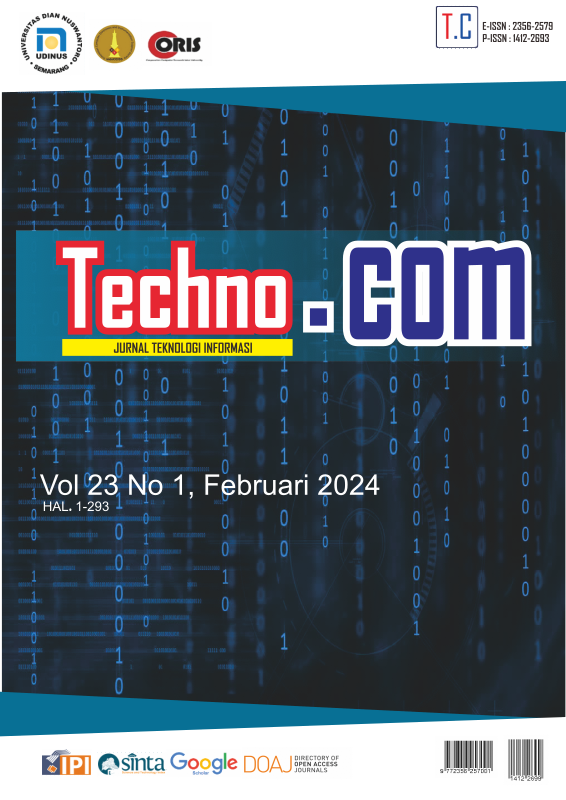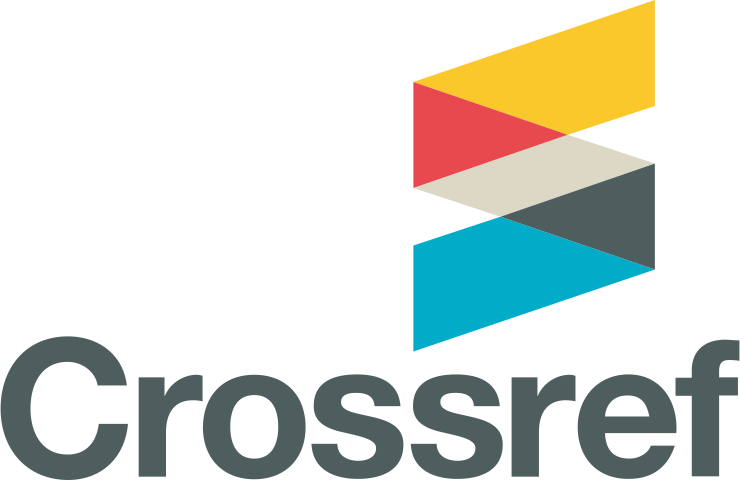Kombinasi Algoritma Huffman dan Rivest Shamir Adleman Untuk Optimalisasi Kapasitas Informasi Pada Quick Response Code
DOI:
https://doi.org/10.62411/tc.v23i1.9421Keywords:
Optimalisasi, Kapasitas QR Code, Kompresi HuffmanAbstract
Quick response code adalah matriks dua dimensi yang dapat menyimpan informasi dalam empat mode pengkodean berbeda. QR Code menawarkan kemudahan dan kecepatan dalam menyimpan dan mengakses informasi sehingga dalam implementasinya terbatas pada penyematan informasi singkat seperti kode produk, tautan website ataupun kode pembayaran. Pada perkembangannya, QR Code seharusnya dapat mengubah kebiasaan manusia dalam menyimpan informasi akan tetapi hal ini sulit dilakukan karena QR Code memiliki batasan karakter bergantung pada metode pengkodean. Oleh karena itu tujuan dari penelitian ini adalah untuk mengoptimalisasi kapasitas informasi pada QR Code dengan mengkombinasikan algoritma Huffman dan metode Rivest Shamir Adleman. Hasil penelitian menunjukan bahwa metode yang diusulkan yaitu flowchart QR Code Generator dan QR Code Reader dapat mengoptimalisasi kapasitas informasi pada QR Code sebesar 81% . Hal ini menunjukan bahwa QR Code versi 40 dengan level L yang memiliki batasan 4296 karakter alfanumerik, dapat dioptimalkan sampai dengan 7775 karakter alfanumerik. Oleh karena itu kesimpulan dari penelitian ini adalah metode yang diusulkan yaitu flowchart QR Code Generator dan QR Code Reader tidak hanya dapat mengoptimalkan kapasitas informasi pada QR Code tapi juga dapat mengamankan informasi yang disematkan pada QR Code dengan tidak mengorbankan kecepatan pemrosesan saat pemindaian.References
K. Rotsios, A. Konstantoglou, D. Folinas, T. Fotiadis, L. Hatzithomas, and C. Boutsouki, “Evaluating the Use of QR Codes on Food Products,” Sustainability, vol. 14, no. 8. 2022, doi: 10.3390/su14084437.
L.-Y. Yan, G. W.-H. Tan, X.-M. Loh, J.-J. Hew, and K.-B. Ooi, “QR code and mobile payment: The disruptive forces in retail,” J. Retail. Consum. Serv., vol. 58, p. 102300, 2021, doi: https://doi.org/10.1016/j.jretconser.2020.102300.
N. Gangurde, S. Ghosh, A. Giri, and S. Gharat, “Ticketing System Using AES Encryption Based QR Code,” in 2022 4th International Conference on Smart Systems and Inventive Technology (ICSSIT), 2022, pp. 201–206, doi: 10.1109/ICSSIT53264.2022.9716234.
R. Jadhav, A. Shaikh, M. A. Jawale, A. B. Pawar, and P. William, “System for Identifying Fake Product using Blockchain Technology,” in 2022 7th International Conference on Communication and Electronics Systems (ICCES), 2022, pp. 851–854, doi: 10.1109/ICCES54183.2022.9835866.
M. Muliyadi, “Optimization Model of Integrated Logistics Using Continuous Review and Greedy Algorithm,” Indones. J. Inf. Technol., vol. 01, no. 02, pp. 20–29, 2017, [Online]. Available: http://usnsj.com/index.php/InJITech/article/view/388.
G. L. Intal, J. D. Payas, L. M. Fernandez, and B. M. Domingo, “Restaurant Information System (RIS) with QR Code to Improve Service Operations of Casual Fine Dining Restaurant,” in 2020 IEEE 7th International Conference on Industrial Engineering and Applications (ICIEA), 2020, pp. 1054–1059, doi: 10.1109/ICIEA49774.2020.9102036.
G. Wang, A. Sutikno, F. Ginting, and N. Angelica, “Applying QR Code in Mobile Banking Use,” in 2021 International Conference on Information Management and Technology (ICIMTech), 2021, vol. 1, pp. 835–839, doi: 10.1109/ICIMTech53080.2021.9534952.
V. D. Dokania, M. M. Sevak, D. D. Patel, and P. S. Barve, “QR Code based Smart Parking System,” in 2020 International Conference on Communication and Signal Processing (ICCSP), 2020, pp. 167–170, doi: 10.1109/ICCSP48568.2020.9182180.
L. Yingli, “Design and Implementation of QR Code Payment in Power Self-service Payment Terminal,” in 2021 6th International Symposium on Computer and Information Processing Technology (ISCIPT), 2021, pp. 432–435, doi: 10.1109/ISCIPT53667.2021.00093.
A. M. Ali and A. K. Farhan, “Enhancement of QR Code Capacity by Encrypted Lossless Compression Technology for Verification of Secure E-Document,” IEEE Access, vol. 8, pp. 27448–27458, 2020, doi: 10.1109/ACCESS.2020.2971779.
O. Appiah, E. M. Martey, C. B. Ninfaakanga, N. S. Awarayi, and E. Opoku, “Performance Evaluation of Corrupted QR Code Scanners,” in 2021 IEEE 8th International Conference on Adaptive Science and Technology (ICAST), 2021, pp. 1–6, doi: 10.1109/ICAST52759.2021.9682029.
C. Bhardwaj, H. Garg, and S. Shekhar, “An Approach for Securing QR code using Cryptography and Visual Cryptography,” in 2022 International Conference on Computational Intelligence and Sustainable Engineering Solutions (CISES), 2022, pp. 284–288, doi: 10.1109/CISES54857.2022.9844332.
S. Tiwari, “An Introduction to QR Code Technology,” in 2016 International Conference on Information Technology (ICIT), 2016, pp. 39–44, doi: 10.1109/ICIT.2016.021.
H. E. Gonçalves, L. X. Medeiros, and A. C. Mateus, “Algorithm for Locating the Vertices of a QR Code and Removing Perspective,” IEEE Lat. Am. Trans., vol. 19, no. 11, pp. 1933–1940, 2021, doi: 10.1109/TLA.2021.9475627.
H. Hidayat and M. Y. Asshobry, “Penerapan Metode Kompresi Huffman untuk Meningkatkan Jumlah Data Informasi pada Kode Quick Response,” JOINS (Journal Inf. Syst., vol. 7, no. 2, pp. 155–165, 2022, doi: 10.33633/joins.v7i2.6789.
C. Bhardwaj and H. Garg, “An Approach for Enhancing Data Storage Capacity in Quick Response Code using Zip Compression Technique,” in 2023 International Conference on Artificial Intelligence and Smart Communication (AISC), 2023, pp. 520–524, doi: 10.1109/AISC56616.2023.10085559.
E. Zuni Astuti and E. Yudi Hidayat, “Kode Huffman Untuk Kompresi Pesan,” Techno.Com, vol. 12, no. 2, pp. 117–126, 2013.
Y. Anshori, A. Y. Erwin Dodu, and D. M. P. Wedananta, “Implementasi Algoritma Kriptografi Rivest Shamir Adleman (RSA) pada Tanda Tangan Digital,” Techno.Com, vol. 18, no. 2, pp. 110–121, 2019, doi: 10.33633/tc.v18i2.2166.
Downloads
Published
Issue
Section
License
License Terms
All articles published in Techno.COM Journal are licensed under the Creative Commons Attribution-NonCommercial 4.0 International (CC BY-NC 4.0). This means:
1. Attribution
Readers and users are free to:
-
Share – Copy and redistribute the material in any medium or format.
-
Adapt – Remix, transform, and build upon the material.
As long as proper credit is given to the original work by citing the author(s) and the journal.
2. Non-Commercial Use
-
The material cannot be used for commercial purposes.
-
Commercial use includes selling the content, using it in commercial advertising, or integrating it into products/services for profit.
3. Rights of Authors
-
Authors retain copyright and grant Techno.COM Journal the right to publish the article.
-
Authors can distribute their work (e.g., in institutional repositories or personal websites) with proper acknowledgment of the journal.
4. No Additional Restrictions
-
The journal cannot apply legal terms or technological measures that restrict others from using the material in ways allowed by the license.
5. Disclaimer
-
The journal is not responsible for how the published content is used by third parties.
-
The opinions expressed in the articles are solely those of the authors.
For more details, visit the Creative Commons License Page:
? https://creativecommons.org/licenses/by-nc/4.0/
















